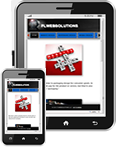


Web design is similar to packaging design for consumer goods. In both cases, people pay for the product or service, but they’re also influenced by the “packaging.”

In this electronic era, more people search online for the products and services they need as opposed to searching through a phone book. Ignoring this important potential marketing platform is akin to saying, "I don't need any new business."

The Internet never sleeps, and every portal you offer online gives your business a virtual 24-hour showroom. This allows potential customers to research your product or service after business hours, and in the privacy of their own home.

So with that in mind it is important to realize that our focus is to engage your visitors interest and prolong their stay so that you profit from the benefits of the professional high quality presence that FLWebSolutions delivers. Whether you are hosting a personal site or a company start-up, we can help you with everything needed to put your site online easily economically and quickly. If you already have a web site, but feel it could benefit from our expertise then we can help.
FLWebSolutions will provide you with a well considered internet strategy coupled with professional web design to deliver a great presentation of your company. We will create you an online presence that is eye-catching and quick to load, easy to navigate and presents a high quality online image for your company its products or services.
Establishing your web presence can be stressful and a bit confusing, especially if you are trying to do it yourself. There are so many areas that require co-ordination to enable your web site to be a success.
All this can be somewhat overwhelming. We will work with you to develop a web site that meets both your business needs and your budget.
If you are working on a tight budget, we can certainly work with you and find a solution. Sometimes, when the budget is really tight, we help our client by giving him the chance to grow in small steps. Maybe designing first, the home page, and adding the rest of the pages as the business grows and funds allow.

As smartphone and tablet adoption rapidly increases, so does the importance of mobile-friendly websites.
If SEO is a core component of your digital marketing strategy, having a mobile-friendly website is becoming essential.
Mobile sales have already overtaken desktop sales, and mobile Internet usage is predicted to overtake desktop internet usage by 2014. It is only logical that mobile search will overtake desktop search at some point in the near future as well.
Since 67 percent of users claim they are more likely to purchase from a mobile-friendly website, companies that rely on SEO are wise to begin making the transition to mobile-friendly websites, and responsive web design specifically.
One of the most appealing aspects of responsive web design is that a responsive website can provide a great user-experience across many devices and screen sizes. This is an important characteristic, since it is impossible to anticipate all the devices and screen sizes searchers will use to access your site. A site that works well regardless of these variables will provide a better and more consistent user-experience than a separate mobile site that is designed for a specific device and screen size.
Let's take the following example. Someone searches for a product on their smartphone during a lunch break at work. They find a site that has the product they're looking for, and decide to continue researching this product on the same site when they get home. Except, when they get home, they will use their desktop instead of their smartphone.
If the site in this example is responsive, this person will have a positive user-experience when transitioning from mobile to desktop because they will view the same site on their desktop as they did on their smartphone. On the other hand, if the site is a dedicated mobile site, this person will become frustrated with the fact that they have to locate the desktop version of the site, and find the product all over again

"Day by day, the number of devices, platforms, and browsers that need to work with your site grows. Responsive web design represents a fundamental shift in how we'll build websites for the decade to come." - Jeffrey Veen

A mobile site is essentially a copy of your website, where the server does the work to deliver an optimized page that's smaller and easier to navigate.
With a mobile site, you must create a different domain (many companies choose to differentiate theirs by "m.domain.com").
This can dilute the domain and hurt organic search traffic. It can also add to website management because you have to maintain two separate silos of content.
Because a mobile site uses a separate domain, links shared from mobile browsers will not count as search link equity toward your primary site.
Re-working of a mobile site might be needed in order to stay current with next-generation phones and mobile browsers.
Could require higher maintenance and expense.
Though they essentially serve the same purpose, websites built on a mobile or responsive framework operate in different ways:
A website built with a mobile framework is essentially a reset of an existing desktop website. It's a custom, separate website (m.yoursite.com or mobile.yoursite.com) designed to provide a user with a unique and optimized smartphone Web browsing experience.
A website built with a responsive code base is an existing desktop website but completely fluid, scaling on the fly as the browser window is adjusted and providing a user with an optimal viewing experience across a wide range of devices - from the biggest desktop computers to the smallest smartphones. In short, a responsive website responds to user control.
Regardless of the framework used to build it, a consumer's first experience with your website may be the first time a consumer experiences your brand. Take advantage of that opportunity - regardless of the device. Don't let your first impression become the last one.

When you need consistency across multiple devices.
Let's revisit your customer, who's likely looking at your traditional desktop website on an iPhone 5. Or was it a Galaxy Note? An iPad? Amazon Kindle? Microsoft Surface? Each of these devices has a different screen resolution - two, technically, if you consider both portrait and landscape layouts.
Again, responsive designs are fluid. They allow a website to respond to the particular device accessing it, giving the user an optimized experience regardless of the platform.
Screen resolution is irrelevant.
Responsive Web design eliminates the need for a separate mobile presence, allowing the website owner to have a single site at a single URL with a single code base and set of files to be used.
This makes a website significantly easier to maintain.
Suggestions, service requests, concerns, comments, feedback...
We will be glad to respond.